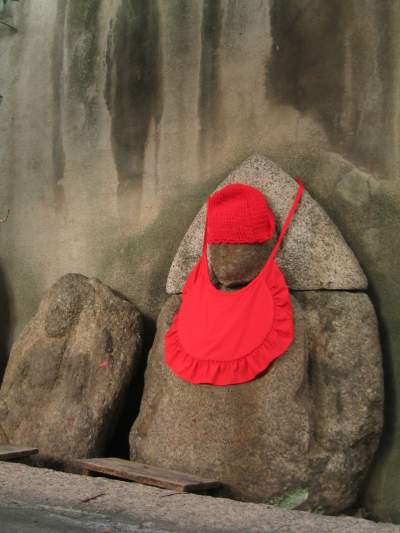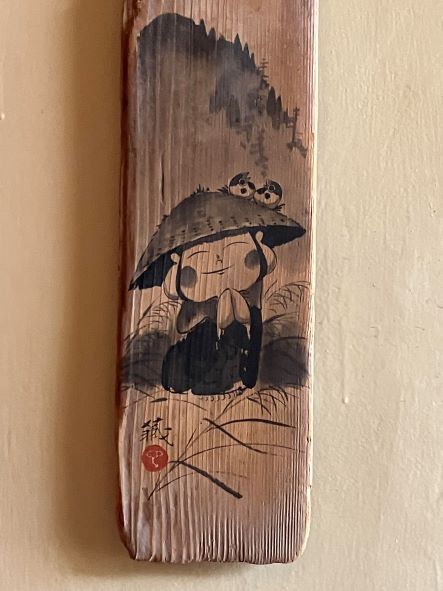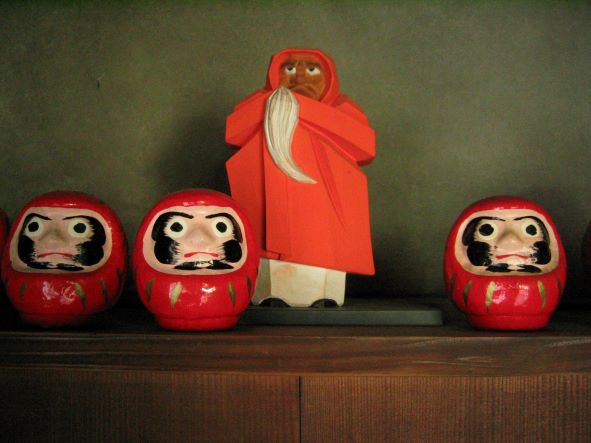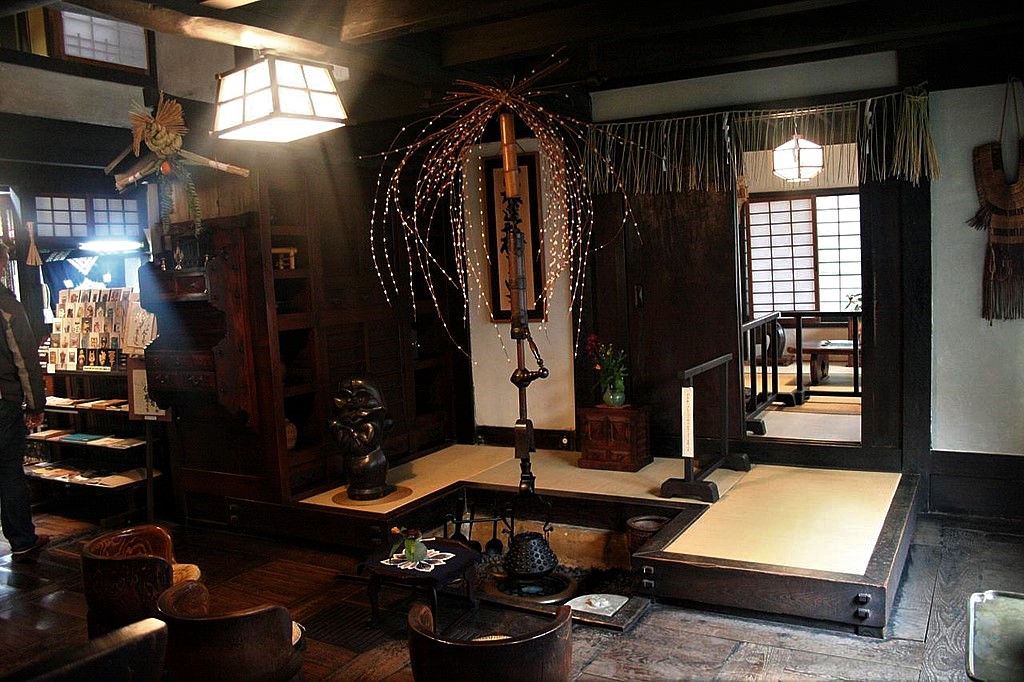Jizo Bodhisattvas, the Bodhidharma, and Kyoto's Kawai Kanjiro Museum

For your next spring Japan trip (or in any other season really) consider adding these three "cultural symbols" to your list of things to experience. One of them can be found in every single tiny local ward or neighborhood anywhere in Japan inside tiny temples no bigger than a small refrigerator; raised off the ground on stone pillars or shelves)
- Jizo Bodhisattvas (protectors of children, pregnant women and travelers; and adorably "cute.")
- Daruma Bodhisattvas (founder of the Shaolin Kung Fu arts, father of Zen Buddhism, and super popular "tool" for reaching goals in Japan today)
- Kyoto's Kawai Kanjiro Museum (a celebration of the 1920s mingei folkcraft movement that succeeded)
All three can be experienced all over the country but, as is so often the case, Kyoto has the best.
Content by Ian Martin Ropke, owner of Your Japan Private Tours (est. 1990). I have been planning, designing, and making custom Japan private tours on all five Japanese islands since the early 1990s. I work closely with Japan private tour clients and have worked for all kinds of families, companies, and individuals since 1990. Clients find me mostly via organic search, and I advertise my custom Japan private tours & travel services on www.japan-guide.com, which has the best all-Japan English content & maps in Japan! If you are going to Japan and you understand the advantages of private travel, consider my services for your next trip. And thank you for reading my content. I, Ian Martin Ropke (unique on Google Search), am also a serious nonfiction and fiction writer, a startup founder (NexussPlus.com), and a spiritual wood sculptor. Learn more!
Jizo Bodhisattvas: Local protectors of children, expectant mothers, firemen, and travelers
One of the most beloved of all Japanese divinities, Jizo works to ease the suffering and shorten the sentence of those serving time in hell. Jizo is the guardian of unborn, aborted, miscarried, and stillborn babies, as well as expectant mothers, firemen, travelers, and pilgrims. Jizo statues can be found everywhere in Japan: in a small shrine in every neighborhood and in graveyards. Though of India origin, Jizo is most common worshipped in daily life in Japan, Korea, and China.
According to tradition, children who die prematurely are sent to the underworld as punishment for causing great sorrow to their parents (their death caused grief to their folks). They are sent to Sai no Kawara, the dry bed of the river of souls in purgatory, where they pray for Buddha's compassion by building small stone towers, piling stone upon stone. But an underworld demon soon arrives and scatters their stones and beats them with an iron club.
But, no need to worry, for Jizo comes to the rescue to help the children. Because of this traditional story, children who die prematurely in Japan are called "mizuko children," or water children, and the saddened parents pray to "Mizuko Jizo."
Even today, you will invariably find little heaps of stones around Jizo statues, as many believe that a stone offered in faith will shorten the time their child suffers in the underworld.

You will also notice that Jizo statues are often wearing tiny garments. Since Jizo is the guardian of dead children, sorrowing mothers bring the little garments of their lost ones and dress the Jizo statue in hopes the kindly god will specially protect their child.
A little hat or bib is often seen as well, the gift of a rejoicing parent whose child has been cured of dangerous sickness thanks to Jizo's intervention.
Roku Jizo (Groupings of Six Jizo)
In Japan, legend also says that there are six paths to hell, and Jizo groupings of six are quite common, one each to protect people from taking the wrong path. Jizo also carries a staff with six rings, which he shakes to awaken us from our delusions. But more accurately, the six forms of Jizo reflect the Six Paths of Transmigration (hell, hungry ghosts, beasts, demons, human beings, and heavenly beings). I'm not sure, but this grouping of six is probably closely related to the symbolic six worlds shown in the traditional Wheel of Life. There are six types of Jizo: Enmei (Long Life), Hosho (Treasure Place), Hoshu (Treasure Hand), Jichi (Land Possession), Hoin (Treasure Seal), and Kengoi (Strong Determination).
Jizo are something that you will see in every neighborhood in Japan, old or new. Look for them on your next Japan stroll.
Daruma dolls and the way of perseverance in Japanese society

One of Japan's more familiar icons is a wobbly black, red and white doll, called a Daruma. Most Daruma are made from paper mache in Takasaki City, Gunma Prefecture, and have large, empty circles where their eyes should be. When a Japanese makes a wish or resolution, one eye is filled in. When the wish comes true or the resolution is fulfilled, the other eye is painted in.
One-eyed Daruma dolls are thus a standard feature of election offices. Large dolls are also often seen at police stations, factories, and even taxi companies where they display the serious intentions of the organization.
One block north from Enmachi, at the intersection of Kyoto’s major Nishioji and Marutamachi boulevards, you will find a Daruma doll fixed to the wall on your right. Turn right (east) there along Shimodachiuri Street; 50 meters further on you will see, on your right the entrance to Horinji Temple, popularly known as "Daruma Dera", the Temple of Daruma.
Founded in 1718, Horinji houses an international collection of over 8,000 Daruma dolls in all shapes and sizes and is the headquarters of the Japan Daruma Group. Daruma is the local name for Bodhidharma, founder of Zen Buddhism. Born into a Indian family of high caste in 470 A.D., legend has it that, at well over a hundred years old, he spent three years journeying to China on a leaf "for no reason."
In China, Bodhidharma was received by the Liang Dynasty Emperor, Wu Ti, who asked him to define the chief principle of Buddhism. Bodhidharma's reply was "Vast emptiness." Bodhidharma retired to the Shaolin Temple on Wu Tai mountain, Hunan Province, where he sat nine years staring at a wall. From this he lost the use of his arms and legs (hence the shape of the dolls) and came to be known as "The Wall-Gazing Buddha".
Every Kung Fu movie fan knows that Shaolin priests practiced a unique form of martial arts. According to legend Bodhidharma, despite considerable disabilities, taught Kung Fu at the temple on Wu Tai mountain. Bodhidharma died in China in 543 at the age of 73, but many years later a Chinese court official on his way to India reported seeing him walking along the road, a sandal slung over his shoulder.
Back to Horinji: In the center of the temple grounds there is a tearoom with a notice inside telling you all about the bunbuku chagama, a tea cauldron famous for the pleasing sound it made when steam lifted its lid. There was no James Watt around at the time, or the steam engine might have been invented centuries earlier! The type of tea ceremony taught at Horinji, by the way, differs from the traditional Japanese one in that sen cha leaf tea, and not the usual powdered tea (known as matcha) is used.
Opposite the tearoom is a stone statue of Daruma sitting atop a sculptural representation of the Japanese cosmos, with the Gods of the Eight Directions inscribed in the base behind the twelve animals of the Chinese Zodiac. Between the statues and the tearoom is a small temple with a large wooden Bodhidharmaon either side of the entrance. The characters above the door read "Nanakorobi Yaoki", a well-known Daruma proverb literally meaning "Fall over seven times, get up eight".
Inside the building there is the collection of Daruma dolls. A large picture of Daruma, painted by Kido Chutaro at 83 years-old, covers the ceiling. Because it's said that if you teach Zen incorrectly, your eyebrows will fall out, the Daruma is always depicted with extra-huge eyebrows. The two large characters in the painting read "Fu To" ("Don't fall over").
Facing you as you leave this interesting little building is the Shuseido, a red and white temple which houses a 400 year-old statue of a reclining Buddha as well as the spirits of some 600 movie stars on its second floor. If you pray while touching the statue, you will gain long life and intelligence--that is, if you don't already have them! By the way, if you walk around the neighborhood of the temple, you might notice that a number of houses have small swastika signs. They indicate that a member of the household practices the martial art taught by the school in the temple--the Japanese version of Shaolin Kung Fu, known as Shorinji Kempo.
Horinji Temple ("Daruma Dera") is located on Shimodachiuri, west of Nishioji, Kamigyo-ku. Open 9:00-16:30 daily, Entry: Yen 300; Tel: (075) 841-7878.
Kawai Kanjiro’s Museum and the tiny ancient neighborhood it lives in

This fantastic museum was originally the longtime residence, workplace, and studio of the ceramic artist Kawai Kanjiro (1890-1966), who, together with Bernard Leach (a world famous British ceramics artist) and Soetsu Yanagi (in Tokyo) and many others, helped to save the fast disappearing traditional folkcrafts of Japan in the 1920’s. [FYI: I studied traditional Japanese woodworking for 7 years with the son of Tatsuaki Kuroda (1904-1982), who was part of the mingei craft revival movement.]
The Kawai Kanjiro Museum would be interesting to anyone who likes wood, ceramics, or old Japan. It was built in 1937 according to Kanjiro’s own design. He also created much of the furniture. The extensive house includes an old rising kiln (noborigama), his studio workshop, a garden area, and small collection of his works.
The museum would be interesting to anyone who likes wood, ceramics, or old Japan. It was built in 1937 according to Kanjiro’s own design. He also created much of the furniture. The extensive house includes an old rising kiln (noborigama), his studio workshop, a garden area, and small collection of his works. The interior of the house has been preserved the way he left it and offers a fascinating and detailed insight into Kanjiro’s life and work. In his words, “life is work, work is life” and this house proves this point perfectly. The interior of the house has been preserved the way he left it and offers a fascinating and detailed insight into Kanjiro’s life and work. In his words, “life is work, work is life” and this house proves this point perfectly.
Open daily 10:00-19:00. Located a tiny bit south-west of the intersection of Gojo and Higashioji. Closed Mondays, except for national holidays when the museum is closed Tuesday). Admission: ¥700 for adults, ¥300 for children. Tel: 561-3585.
Return to the Japanese culture essay index.
Content by Ian Martin Ropke, owner of Your Japan Private Tours (est. 1990). I have been planning, designing, and making custom Japan private tours on all five Japanese islands since the early 1990s. I work closely with Japan private tour clients and have worked for all kinds of families, companies, and individuals since 1990. Clients find me mostly via organic search, and I advertise my custom Japan private tours & travel services on www.japan-guide.com, which has the best all-Japan English content & maps in Japan! If you are going to Japan and you understand the advantages of private travel, consider my services for your next trip. And thank you for reading my content. I, Ian Martin Ropke (unique on Google Search), am also a serious nonfiction and fiction writer, a startup founder (NexussPlus.com), and a spiritual wood sculptor. Learn more!